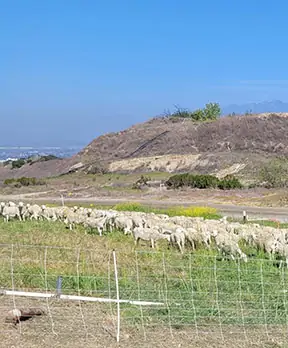

Among the extensive list of landfill operating costs are those incurred for landscaping to keep the slopes trimmed. While regularly mowing large spaces is expensive, keeping sites well-groomed is essential for protecting landfill covers and providing other safeguards. Putting sheep and other grazing livestock to work eliminating invasive plants and other vegetation from properties difficult to traverse for two-legged workers could be a good alternative. Grazing is an often useful technique for maintaining traditional native plants while reducing weeds and unwanted vegetation, mitigating risk for growth to dry out and possibly catch fire or intrude on a site’s pipelines and infrastructure.
In municipal solid waste landfills near urban areas, such as in Pennsylvania, Arizona, and California, grazing animals are helping with slope management. These locations also reap environmental benefits of reduced soil erosion; improved air and water quality; better plant diversity, vigor and production; and improved wildlife habitat.
As with all landfill operations, planning is everything. The choice of grazing animal (i.e., sheep, goats, cattle, or horses) and the number of animals necessary is site-specific. To determine the best choices, SCS Engineers looks at site characteristics such as the age of the plants and the proportion of grass species present, the local climate, and wildlife species present.
A landfill operator in California using sheep to groom landfill slopes is pleased with the results after three months and plans to continue the grazing method in the upcoming years. “We use 400 sheep per acre, per day, and have 600 on-site.”

“We talked about it for years before we implemented this method,” he says. “We needed time to research the feasibility and the costs, but that isn’t a challenge for SCS; their environmental scientists have landfill expertise in gauging air, soil, water, inorganic and organic content. These are all conditions requiring careful consideration before bringing in sheep to graze.”
The operator was sold on grazing, seeing the environmental, economic, and safety benefits of this alternative to herbicides and staff maneuvering trimming equipment on steep slopes. Finding a shepherd was the next step. With all its benefits, the method does require human oversight.
Luis lives at the landfill in a trailer home, his base of operations. He grew up in Peru, herding sheep. The landfill operations staff trained him on landfill safety, and Luis, in turn, teaches landfill staff what to expect from the 600 sheep.
The herd grazes during daylight hours, clearing patches of mustard grass and weeds. “Sheep are a better choice than goats here; they are more selective and won’t eat native plants or damage the infrastructure by trying to eat it too,” says the landfill operator.
As the sheep graze on invasive grasses, they are preventing tumbleweeds and destroying the seeds while chewing. A further benefit is the fertilizer they leave behind supports the growth of native plants that require minimal grooming, are tolerant of dry conditions, and facilitate the protection of the landfill cover.
“Around here, where the climate is very dry, preventing tumbleweeds and flammable conditions is a priority. The herd is packing the groundcover down while they’re eating, providing a great alternative to mowing while helping control runoff,” says the operator.
The herd is low maintenance, thriving outdoors without shelter and needing only to have their water troughs filled. The shepherd has two helpers, a border collie for herding the sheep to new locations and another larger dog to help protect the sheep from coyotes. Both the dogs and the wildlife help cut down the number of burrowing animals, which for obvious reasons are not landfill-friendly.
Occasionally, the landfill operation staff helps Luis move the herd. He sets up new locations across the landfill as the sheep are grazing in another area. Then the dogs help move the herd to the new location. Keeping the sheep going in the right direction is hard work, explains SCS’s Regional Manager. “If one sheep breaks off, twenty more will follow. Depending on where we’re moving them, Luis may need extra hands.”

This natural “landscaping” alternative with all its landfill-specific benefits is working well. The sheep can do some damage, they sometimes rub along exposed pipelines scratching themselves, but the staff is quickly alerted to anything broken. Luis uses a lightweight grid fence to corral the animals. The battery-powered fencing helps protect the sheep at night from coyotes with a light “shocking” deterrent, similar to static electricity. It’s enough to keep the carnivores at bay along with the dogs’ help.
The SCS landfill operations team has adopted the two dogs. Their Field Services Regional Manager points out, “We didn’t plan on adopting them, but we just couldn’t help ourselves. These are hardworking animals, and Guardian, the dog protecting the sheep at night, can get Foxtail, a grass-like weed, caught in his fur. The seeds can injure dogs, so we inspect and brush them, and we watch to ensure they stay healthy. These dogs, like the sheep, are part of the team and important to helping maintain the landfill − not to mention they’re special to us.”
The sheep, dogs, and Luis are doing an exemplary job. The operator expects in two or three seasons to see a significant improvement in maintenance; each consecutive year, there is less undesirable vegetation. “It’s working well; next year, we will start grazing in January to help prevent more invasive new growth earlier in the season,” he says.
“Environmentally, I like to think we’re helping our client be a good neighbor,” he continues. “And we save the landfill 66 percent of their landscaping budget every year; that helps us all sleep better.”
The U.S. Environmental Protection Agency recommends ecological restoration and revegetation of landfills, abandoned dumps, mines, and other site containment systems designed to protect people and the environment from exposure and prevent contaminant migration. Grazing is one cost-effective and efficient option to consider supporting these priorities.
Find more landfill engineering and operations information.